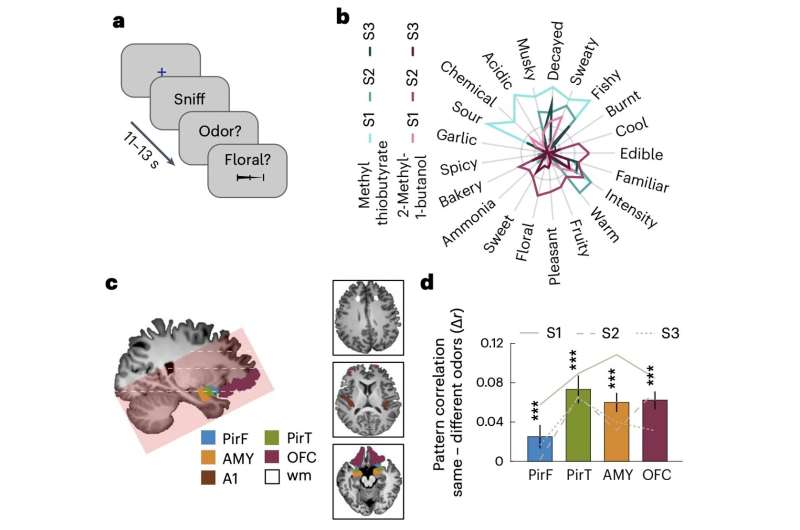Study sheds light on the neural underpinning of subjective odor perceptions

Different people can have varying perceptions of the same scents and odors, for instance perceiving the same perfume as “fruity” or “musky.” Studies have suggested that the ways in which the same odors are mapped in the brain of different individuals are highly flexible, particularly compared to visual stimuli, which are typically represented similarly.
The distributed and varied brain activity patterns evoked by smelling different odors are now well-documented. However, the processes through which these patterns result in subjective odor perceptions remain poorly understood.
Researchers at Northwestern University, Rhodes College, University of Pennsylvania and the National Institute on Drug Abuse, part of the NIH, recently carried out a study aimed at better understanding these mechanisms. Their paper, published in Nature Neuroscience, identifies a brain region that appears to play a crucial role in the subjective perception of smells.
“It is well established that odors evoke distributed patterns of activity in the brain,” Dr. Thorsten Kahnt, Investigator in the Intramural Research Program at the NIH’s National Institute of Drug Abuse and senior author on the paper, told Medical Xpress. “The open question that we set out to answer in this project was how these activity patterns are systematically related to subjective odor percept.”
To better understand what happens in the brain while processing different odors, Dr. Kahnt and his colleagues carried out a series of experiments involving human participants. These participants were asked to smell a wide range of odors and share their subjective perceptions for each one, while the researchers recorded their brain activity.
“We selected 160 unique odor stimuli and asked research participants to rate each of these odors on 18 different perceptual descriptors (e.g., how ‘fruity,’ ‘sour,’ ‘floral,’ ‘cool,’ etc. each odor smelled to them),” Dr. Kahnt explained. “We also used functional magnetic resonance imaging (MRI) to collect brain responses to the same odors from the same participants. This allowed us to determine the degree to which the brain represents the perceptual quality and/or chemical structure of odors.”
When they analyzed the brain recordings collected during their experiments, the researchers found that the orbitofrontal cortex (OFC), a brain region known to play a key role in emotion and reward-based learning, prioritized representations of fine-tuned aspects of odors over broader perceptions. Notably, this preferential representation of fine-tuned elements did not appear as pronounced in the amygdala and piriform cortex (PirC), other brain regions associated with odor processing.
“Our findings shed light onto the mechanisms by which the brain creates our subjective perception of smells,” Dr. Kahnt said. “Specifically, they identify the OFC as an area in which the most detailed and subjective percepts reside. Dysfunction in this area is implicated in several neuropsychiatric disorders, and our findings add to the field’s understanding of this important brain structure.”
The recent work by Dr. Kahnt provides crucial evidence hinting at the key role of the OFC in enabling subjective perceptions of odors, which were consistently observed in past psychology and neuroscience studies. In the future, it could help to better understand odor-related dimensions of mental health disorders linked to dysfunctions in the OFC, such as anxiety and depression.
“Our current findings are based on correlational methods,” Dr. Kahnt added. “In the future, we will use brain stimulation methods to test the causal role of these brain areas. For instance, we can experimentally modulate orbitofrontal cortex activity and measure resulting changes in the quality of odor perception.”
More information:
Vivek Sagar et al, High-precision mapping reveals the structure of odor coding in the human brain, Nature Neuroscience (2023). DOI: 10.1038/s41593-023-01414-4
Journal information:
Nature Neuroscience
Source: Read Full Article

